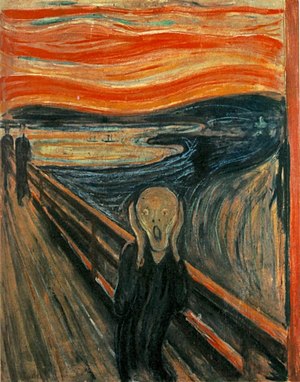Anxiety disorders
| Anxiety disorder | |
|---|---|
 |
|
| The Scream (Norwegian: Skrik) a painting by Norwegian artist Edvard Munch | |
| Classification and external resources | |
| Specialty | Psychiatry |
| ICD-10 | F40-F42 |
| ICD-9-CM | 300 |
| DiseasesDB | 787 |
| eMedicine | med/152 |
| MeSH | D001008 |
Anxiety disorders are a group of mental disorders characterized by feelings of anxiety and fear. Anxiety is a worry about future events and fear is a reaction to current events. These feelings may cause physical symptoms, such as a fast heart rate and shakiness. There are a number of anxiety disorders: including generalized anxiety disorder, specific phobia, social anxiety disorder, separation anxiety disorder, agoraphobia, panic disorder, and selective mutism. The disorder differs by what results in the symptoms. People often have more than one anxiety disorder.
The cause of anxiety disorders is a combination of genetic and environmental factors. Risk factors include a history of child abuse, family history of mental disorders, and poverty. Anxiety disorders often occur with other mental disorders, particularly major depressive disorder, personality disorder, and substance use disorder. To be diagnosed symptoms typically need to be present for at least six months, be more than would be expected for the situation, and decrease functioning. Other problems that may result in similar symptoms including hyperthyroidism, heart disease, caffeine, alcohol, or cannabis use, and withdrawal from certain drugs, among others.
Without treatment, anxiety disorders tend to remain. Treatment may include lifestyle changes, counselling, and medications. Counselling is typically with a type of cognitive behavioural therapy. Medications, such as antidepressants or beta blockers, may improve symptoms.
...
Wikipedia
